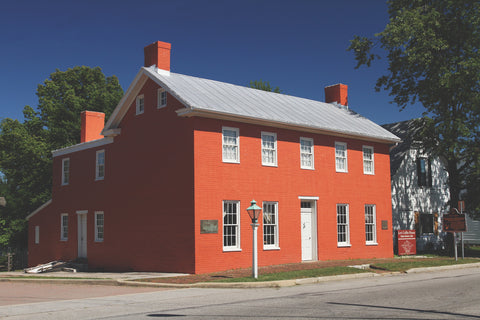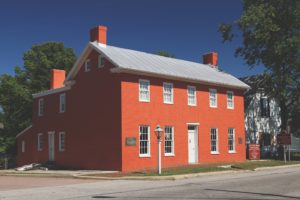
The Levi and Catharine Coffin House State Historic Site: The Grand Central Station of the Underground Railroad

The Levi and Catharine Coffin House in Fountain City, Ind., may seem off the beaten path for Civil War aficionados, but that was not the case for thousands of enslaved people in antebellum America, for whom it was a symbol of incredible hope—appropriately labeled the “Grand Central Station of the Underground Railroad” in the 1840s. Today the restored house and its barn are part of the Levi and Catharine Coffin State Historic Site, which also features an exceptional interpretive center that helps put in perspective the vital role the Coffin family played during the buildup to the Civil War.
Originally from North Carolina, Levi Coffin and his wife, Catharine, were Quakers who strongly opposed slavery and eventually moved to Indiana, where they would live for 20 years in what was known at the time as Newport. The small town of Fountain City is not far from the Indiana–Ohio state line in Wayne County, about 93 miles northeast of Indianapolis via Interstate 70.
Abolitionist and slavery themes are present as soon as you enter the Interpretive Center. A dual-purpose timeline on the first floor provides a look at the history of slavery and the law and also examines the rich Coffin family history. One of the first things you will see is a telling quote by Levi: “I date my conversion to Abolitionism from an incident which occurred when I was about seven years old. It made a deep and lasting impression on my mind, and created that horror of the cruelties of slavery which has been the motive of so many actions of my life.”
Despite the peril, Levi and Catharine were fully committed to assisting freedom seekers make their way to Canada. They would help liberate more than 1,000 freedom seekers while they resided in Newport.
The Interpretive Center’s second floor has a self-guided exhibit gallery titled “Souls Seeking Safety,” where the challenge of telling such a rich story in a relatively small space is more than met. Photographs, graphics, text, and interactives in the gallery blend seamlessly for a rewarding experience.
The interactives adopt both a physical and passive approach. Visitors, for instance, learn the story of Henry “Box” Brown by lifting the lid of a reproduction of the crate that Brown used to ship himself to freedom, a journey lasting 27 hours. Another exhibit looks at Catharine’s sewing circle as its members discuss abolitionism. The most powerful interactive, however, is a cutaway reproduction of a false-bottomed wagon used to transport freedom seekers to and from the Coffin House. Placing your head in the concealed rider’s space, you can hear the sounds of the road, including a conversation between a wagon driver and bounty hunter.
Another nice feature is a lighted map showing key cities and the confluence of three major routes near the Coffin House that freedom seekers used to cross the Ohio River: Cincinnati, Ohio; Jeffersonville, Ind., and Madison, Ind. Nearby Quaker settlements providing further support are shown.
As is the case in many such house tours, there is great focus on the Coffin House’s architecture and furnishings. The spaces and voids tell a key story, as they provided freedom seekers refuge—spaces in which they could hide, eat, sleep, and dream of freedom until the next leg of their journeys. Notably, visitors enter the house through a side door, the same threshold that freedom seekers crossed in the 19th century.
The furnishings are primarily of the period. The first floor has a kitchen, a guest room, and a sewing/sitting room where Catharine’s sewing circle made clothes for the freedom seekers. The kitchen area has a discreet curved staircase that visitors can use to enter an upstairs bedroom under the roof’s eave. The short door in the shortest wall of the room provides access to a garret, space capable of housing up to 14 freedom seekers. Visitors can peer through the doorway to see that precarious hiding place.
Tours of the Levi and Catharine Coffin State Historic Site are a powerful experience, well worth your time. To date, reservations are required for tours and numbers are limited due to pandemic-related guidelines.
The Interpretive Center is ADA-compliant; however, the Coffin House does pose challenges for visitors with limited mobility. The staff makes every effort to provide full access to the house, offering visitors with mobility issues alternate ways to gain access to certain rooms, including an alternate wider staircase to the upper floor and alternate entryways to the basement.
For those confined to wheelchairs, the first floor is readily accessible. Upon request, staff will provide visitors photographs or a link to a virtual tour exploring the second floor.
To find out more about the Levi and Catharine Coffin House State Historic Site, go to indianamuseum.org/historic-sites/levi-catharine-coffin-house.

